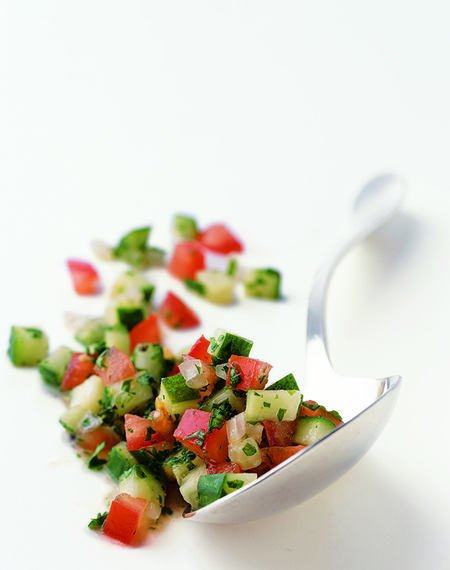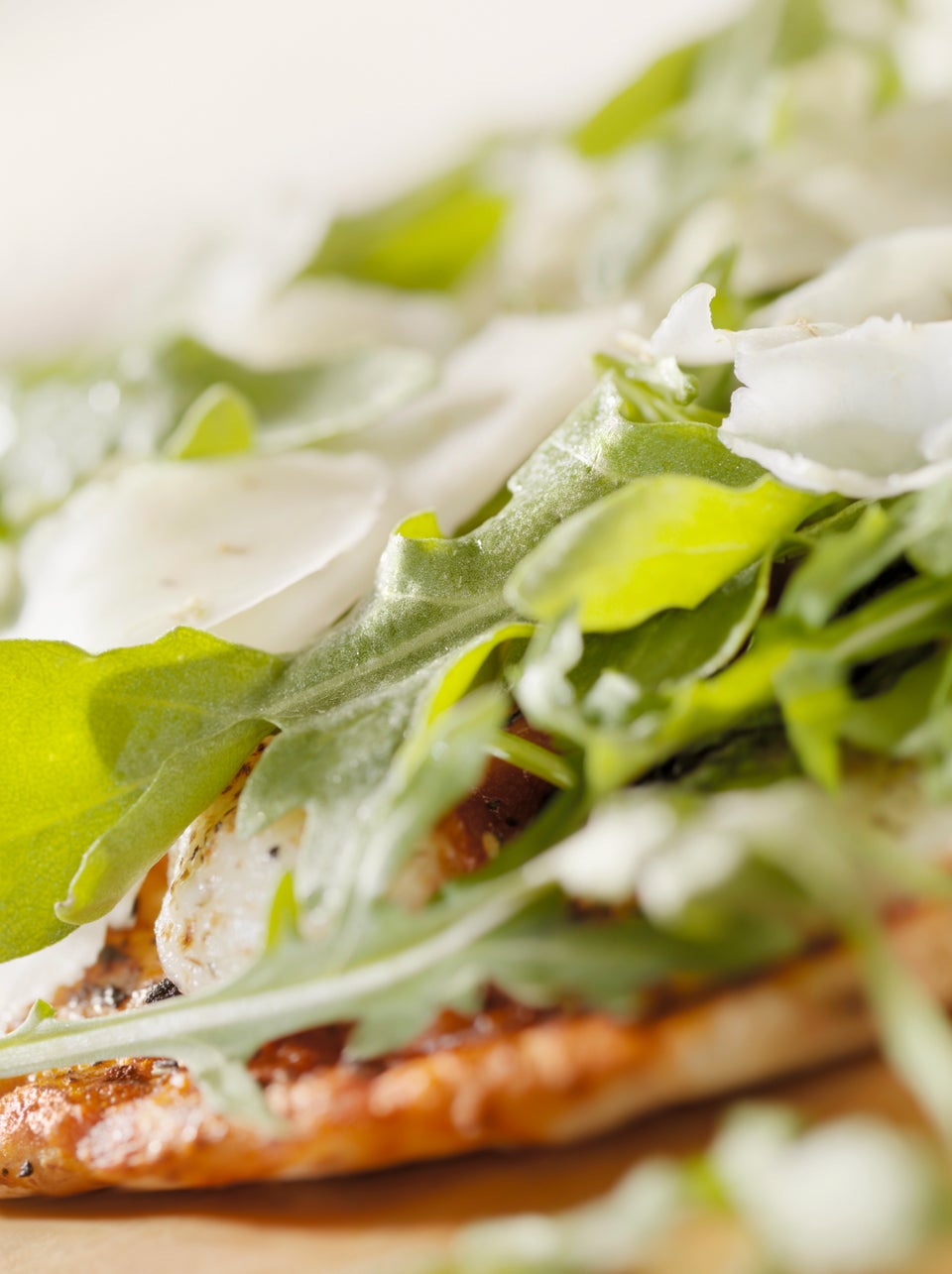These options seem innocent but they're actually undermining your healthy meal.
By Perri O. Blumberg, SELF
Why did the salad cross the road? To slather itself in the creamy dressings. And pack on the honey-glazed nuts. And, oh yeah, bask in the crunch of croutons.
Eating a hearty salad can flood your cells with antioxidants, vitamins and minerals--until you turn it into a joke with a bunch of sneaky toppings that sabotage the nutritional value. To avoid these mistakes, read on for these bits of wisdom from top nutritionists.
Dried Fruit
If you have a sweet tooth, it's easy to think dried fruit will both satisfy you while providing nutrition. But you should skip the Craisins or mango strips, explains Julieanna Hever, MS, RD, CPT, Plant-Based Dietitian, author of The Vegiterranean Diet and The Complete Idiot's Guide to Plant-Based Nutrition. "Dried fruit looses its water and turns calorie-dense in the dehydrating process," she says. "It also often contains added oils and sugars."
The best swap: "For added sweetness in your salad, try fresh grapes, apples, or blueberries for a fiber-punch with less sugar," suggests Kayleen St.John, Nutritionist Kayleen St. John, RD, at New York City's Natural Gourmet Institute, a health-supportive culinary school. Of course, all fresh fruit--from everyday oranges to tropical pineapple--are welcome additions to salads since they're plentiful in antioxidants, vitamins and minerals.
Make this today: Grilled Peach and Heirloom Tomato Salad
Salted or Roasted Nuts/Seeds
You might think a sprinkling of salted nuts are fair game to swirl into your nutritious salad, but think again: "These are also typically roasted in unhealthy fats (rancid vegetable oils) which are terrible for your heart and body," shares Peggy Kotsopoulos, RHN, nutritionist, and author of Kitchen Cures. "Plus, they are way higher in fat and calories and the excess sodium they provide is terrible for blood pressure."
The best swap: Seek out unsalted, raw nuts and seeds. "These provide a healthy dose of proteins and fats, and are a great source of B vitamins that are essential for optimal nervous system function." Kotsopoulos says. Even better? Try sprouted nuts and seeds. With these, enzyme inhibitors are eliminated, making the nuts easier to digest and the nutrients easier to assimilate.
Make this today: Kale Salad with Dates, Parmesan and Almonds
Corn and Other Starchy Veggies
In moderation, corn and peas can be great toppings, but going overboard with them is where you tip off the balance of your salad's nutritional profile. "Starchy vegetables provide fiber and plenty of nutrients, but these are the highest in carbohydrates," explains St. John. "When added in large quantities, they can really increase the glycemic response of your salad."
The best swap: "Stick to just one starch for your salad and keep the serving size less than one cup," cautions St. John. For a dose of fiber-packed whole-grain goodness, try sorghum, bulgur or wheat berries.
Make this today: Savory Wheat Berry Salad
Bacon Bits
When it comes to crafting a healthy salad, you're definitely going to want to avoid processed meats, like bacon bits. "These products increase your risk for colorectal cancer significantly," Hever says. "The American Institute for Cancer Research suggests avoiding them altogether."
The best swap: Just because you're giving up a handful o' bits, doesn't mean you have to give up meaty flavor. "Instead, add roasted chickpeas, beans, or tempeh for a savory, health-promoting, cancer-fighting protein source and flavor-boost," offers Hever.
Make this today: Buckwheat Salad with Tempeh and Sesame Dressing
Fat-Free Salad Dressings
Simply put: "Fat-free salad dressing should be renamed, 'high sugar dressing.' Plus, most of these dressings are usually loaded with other chemicals and don't even taste good," comments Keri Glassman, MS, RD, celebrity nutritionist and founder of Nutritious Life.
"There is actually a direct correlation between the increase in fat-free foods and increase in societal weight-gain," adds Kotsopoulos. "When fat is removed, it's often replaced with chemicals, fillers, sugars and other icky artificial flavors, which all wreak havoc on our bodies," she continues.
The best swap: In reality, your body needs fat--especially in a salad. Pairing "fat-soluble" vitamins like A,D, E and K with healthy fat (like a tahini dressing or a scoop of avocado) actually helps your body absorb the vitamins.
"Make your own homemade salad dressing with extra virgin olive oil or avocado oil. These oils are heart-healthy, great for your body and help absorb those precious nutrients veggies provide," says Kotsopoulos.
Make this today: Mint-Tahini Dressing
Creamy Salad Dressings
The salad dressing police strikes again: "Creamy salad dressings are often loaded in unhealthy saturated fats and calories. They also contain many chemical ingredients, sugars and additives which can turn your once-healthy salad into a completely unhealthy bowl," explains Kotsopoulos.
The best swap: You don't need to rely on bottled dressings to add depth of flavor and a velvety textural element to your salad. For added creaminess, Kotsopoulos likes stirring in hummus or greek yogurt to a batch of DIY dressing. "Or blend in some avocado. These whole food ingredients provide the creaminess you crave in dressings, while adding extra nutrients to your salad."
Make this today: Everyday Avocado Dressing
Dairy Cheese
Betcha can't have just one...feta crumble, that is. "Dairy cheese is our biggest source of saturated fat in the diet and promotes cardiovascular disease and type 2 diabetes," warns Hever. Ditching dairy doesn't mean missing out on calcium; you can add plenty of plant-based items like broccoli, sweet potatoes and Great Northern beans, just to name a few.
The best swap: Try cubed, baked tofu (like in a Greek salad in lieu of feta) or a nut-based cheese alternative. Warning: Vegan "cheese" can contain additives and chemicals, just like the real deal; so look for ingredient lists with whole foods and words you can pronounce.
Make this today: Grilled Vegetable Salad with Tofu
Croutons
Your #foodstagram may be begging for a handful of croutons to top your salad, but doing so won't do much for its nutritional prowess. While they may provide a satisfying crunch, the croutons you buy at stores are basically empty calories with no added health benefits.
The best swap: "Instead of store-bought croutons, toast a piece whole grain bread, crumble it into small pieces, and sprinkle it with nutritional yeast for a crunchy, toasty, fiber-rich option," suggests Hever. Nutritional yeast is also often fortified with B12, making it a great plant-based source of this necessary vitamin.
Make this today: Mediterranean Chef Salad With Polenta Croutons
Crunchy Noodles
"First, they're fried. Why add fried anything to your bowl of antioxidant goodness?" asks Glassman. "Next, they provide calories without any nutrients, and their high sodium content is only going to make you bloat."
The best swap: "Add crunch by using a teaspoon of sunflower seeds or a crunchy veggie like jicama," suggests Glassman.
Make this today: Jicama Salad with Lime Juice and Fresh Mint
More from SELF:
4 Delicious Foods You Can Grill (That Aren't Steak!)
The Genius Trick for Perfect Scrambled Eggs
What's Your Sex Number?
The One Thing Hairstylists Wish You'd Stop Doing
5 Relationship Red Flags That Don't Have to Be Dealbreakers
The One Thing Dermatologists Wish You'd Stop Doing
4 Things Men Hide From Their Wives
Also on HuffPost:

